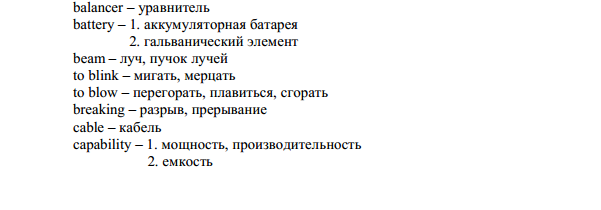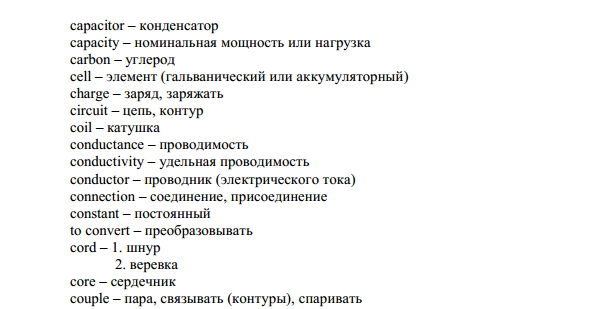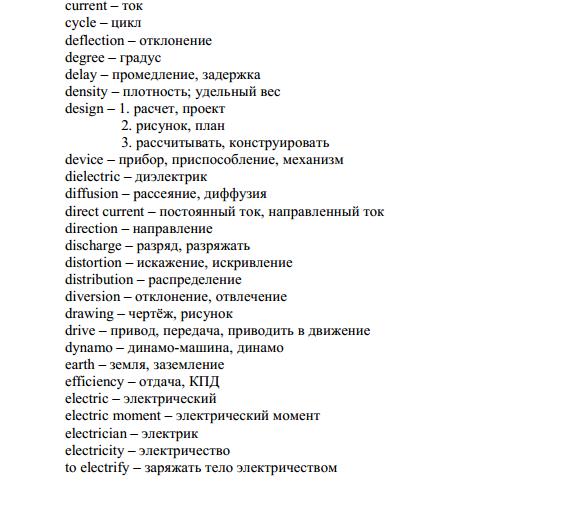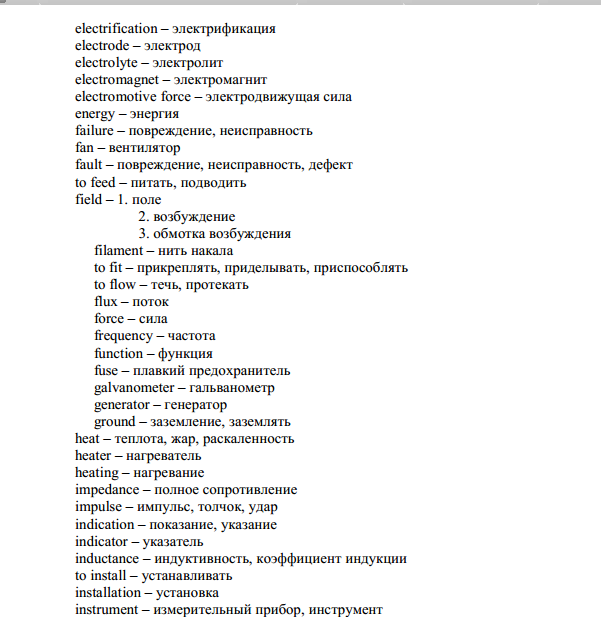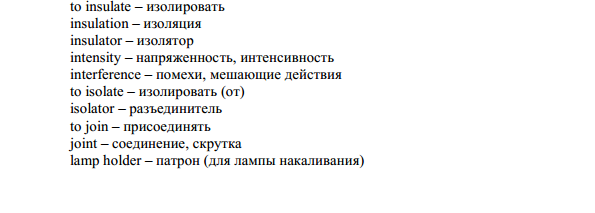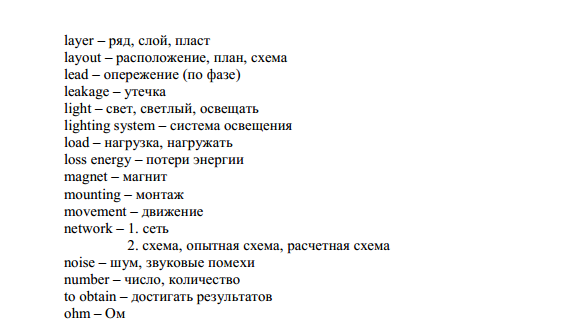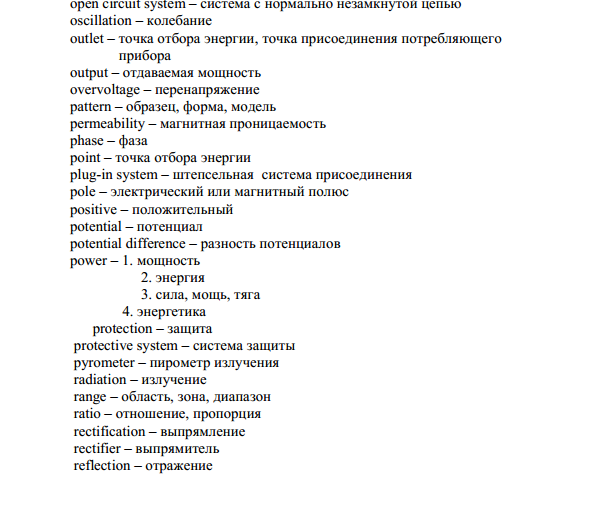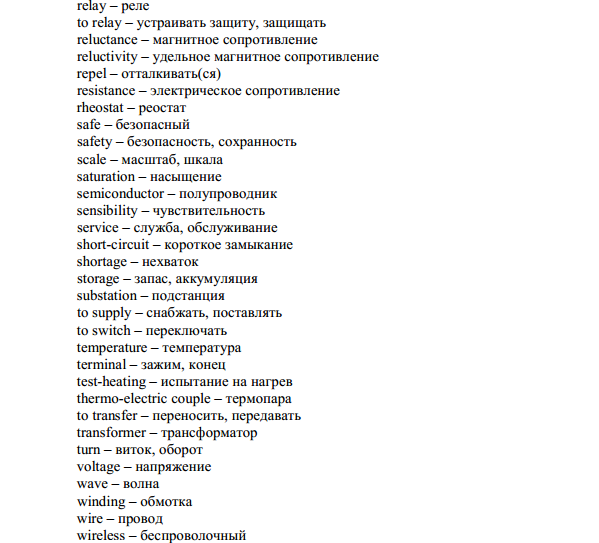ВУЗ: Не указан
Категория: Не указан
Дисциплина: Не указана
Добавлен: 10.04.2024
Просмотров: 146
Скачиваний: 0
ВНИМАНИЕ! Если данный файл нарушает Ваши авторские права, то обязательно сообщите нам.
4. Choose the correct variant:
1. А transformer is used а) to reduce power. b) to receive power. с) to transfer power.
2. The primary winding а) receives energy. b) supplies energy.
3. А step down transformer а) increases the voltage. b) decreases the voltage.
4. А transformer with an iron core is used а) for low frequency currents. b) for high frequency currents.
5. The nameplate is attached а) to the frame. b) to the tank.
6. The tank contains а) air. b) oil.
7. Faults in а transformer result from а) overheating. b) stresses. с) short-circuits.
5. Complete the sentences:
1. The primary winding receives energy while ... . 2. А step down transformer decreases the voltage while … . 3. А transformer with an air core is used for high frequencies while ... . 4. In a step up transformer the number of turns in the secondary winding is greater that the number of turns in the primary while ... . 5. The greater is the quantity of heat the greater is the cooling required while ... .
6. Answer the questions:
1. What is а transformer used for? 2. What parts does it consist of? 3. What is the function of the primary (secondary) winding? 4. What is the difference between а step up and а step down Т? 5. What frequencies is an air (iron) core Т used for? 6. Where are the core and the windings placed? 7. What liquid does the tank contain? 8. Why does а Т require cooling? 9. What are the common faults in а Т? 10. What do they result from? 11. То what part is the nameplate attached? 12. What data does it bear?
7. Translate the text in writing. Use а dictionary:
High-Voltage Transformer
А great number of different types of transformers are in use nowadays. А high-voltage transformer is one of the newly constructed ones.
This transformer is intended for outdoor installation. Its highest system voltage is 75.5 to 525 kV; maximum number of cores is 6 and frequency – 50 and 60 Hz.
The transformer is applied in high voltage installations and for energization of network protection relays. The device has unlimited electrodynamic short-circuit strength of the primary conductor. Protection cores are suitable for overcurrent requirements as well as for reliable transformation of short-circuit currents. For external insulation hard porcelain is used and for the main insulation paper / oil insulation is used.
8. Translate the words and the word-combinations:
disappearance, overproduction, uselessness, outdoor, indoor, poorly operating relay, manually-operated switch, unearthed live tank
BATTERIES
An Italian scientist Alessandro Volta made a lot of experiments with electricity. Batteries as sources of electrical energy are the result of his experiments.
Today battery cells are produced in two common forms: dry cells, used in flashlights, portable radios, clocks, cameras and (well) wet cells, used in automobiles, airplanes, boats.
The voltaic cell is composed of three parts: a pair of dissimilar metal plates called electrodes, a dilute acid solution called electrolyte, and a nonconducting container called the cell. In a glass container filled with sulphuric acid there are two plates: one copper and are connected by a copper wire, electricity will flow through it from the copper plate to the zinc plate.
For the voltaic cell the copper plate is the positive electrode and the zinc plate the negative electrode a copper wire will convey electricity and is called an electrical conductor. Copper, aluminium and silver are good conductors. They must be surrounded by protective material which does not conduct electricity. Such materials are called electrical insulators (glass, wood, rubber, some plastics, insulation tape)
Remember that faulty insulation is dangerous and leads to unwanted electrical flow and probably to local overheating.
Vocabulary:
Source – источник
Cell – элемент
Flashlight – сигнальный огонь
Plate – пластинка
Acid – кислота
Copper – медь
Wire – проволока, провод
Insulator – изолятор
Rubber – резина, каучук
Tape – лента, тесьма
To use – использовать
To compose – составлять
To fill – наполнять
To connect – соединять
To flow – течь
To convey – переправлять
To surround – окружать
To remember – помнить
Common – общий, частый
Portable – переносной
Dry – сухой
Wet – мокрый
Dissimilar – несходный
Sulphuric – серный
Faulty – неисправный
Dangerous – опасный
1. Finish the sentences according to the text:
-
A battery is a source of …. -
Battery cells are manufactured in …. -
The voltaic cell is composed of …. -
Cells connected together form …. -
The positive electrode is …. -
The negative electrode is …. -
Series connection means …. -
Materials which do not conduct electricity are called ….
2. Translate the text and put down the translation into your copy books.
REVISION TEST
-
Translate the following words into Russian:
-
accelerator; -
adjuster; -
alarm system -
alternating current; -
to approach; -
to assemble; -
attraction; -
battery; -
to blow; -
breaking; -
capability; -
capacitor; -
cell; -
circuit; -
coil; -
conductor; -
to convert; -
core; -
cycle; -
density.
-
Translate the following words into English:
-
прибор; -
диффузия; -
разряд; -
распределение; -
привод/передача; -
отдача/кпд; -
электричество; -
электролит; -
ЭДС; -
повреждение; -
протекать; -
частота; -
предохранитель; -
генератор; -
показание/указание; -
изолятор; -
разъединитель; -
отдаваемая мощность; -
разность потенциалов; -
мощность; -
сопротивление; -
полупроводник.
-
Match the following words to the translation:
-
capacity; -
connection; -
charge; -
current; -
distortion; -
to electrify; -
to feed; -
filament; -
force; -
impedance; -
inductance; -
interference; -
load; -
loss energy.
-
нагрузка; -
питать; -
помехи; -
соединение; -
номинальная мощность; -
заряжать; -
нить накала; -
потеря энергии; -
индуктивность; -
ток; -
искажение; -
заряд; -
полное сопротивление; -
сила.
-
Match the terms to appropriate definitions:
-
alternating current; -
direct current; -
electricity; -
transformer; -
conductor; -
insulator; -
semiconductor; -
frequency; -
resistance; -
short-circuit;
-
electricity can easily pass through or along this substance; -
it causes a disruption of electric circuit; -
it is an electric current that continually changes its direction while flowing; -
it means the number of cycles per second; -
it is a material of low conductivity; -
it is a kind of electric current the always flows in the same direction; -
it is a measure of object’s opposition to the flow of electric current; -
it is a substance whose ability to conduct electricity increases with heating; -
it is a form of energy that can be carried by wires and is used for heating and lighting; -
it changes a voltage to a higher or lower voltage.
-
Translate the following sentences into English:
-
Степень сопротивления проводника зависит от материала, из которого он изготовлен. -
Сопротивление материала изменяется по мере его нагревания. -
Самыми хорошими проводниками являются: медь, серебро и алюминий. -
Такие материалы как стекло, дерево и бумага имеют очень высокую степень сопротивления. -
Томас Эдисон и Никола Тесла внесли огромный вклад в изучение электричества. -
Электрический ток – это упорядоченное движение свободных электрически заряженных частиц. -
Электроны являются отрицательно заряженными частицами. -
Первая в мире электростанция (power plant) была открыта в Америке в 1882 году.
VOCABULARY

